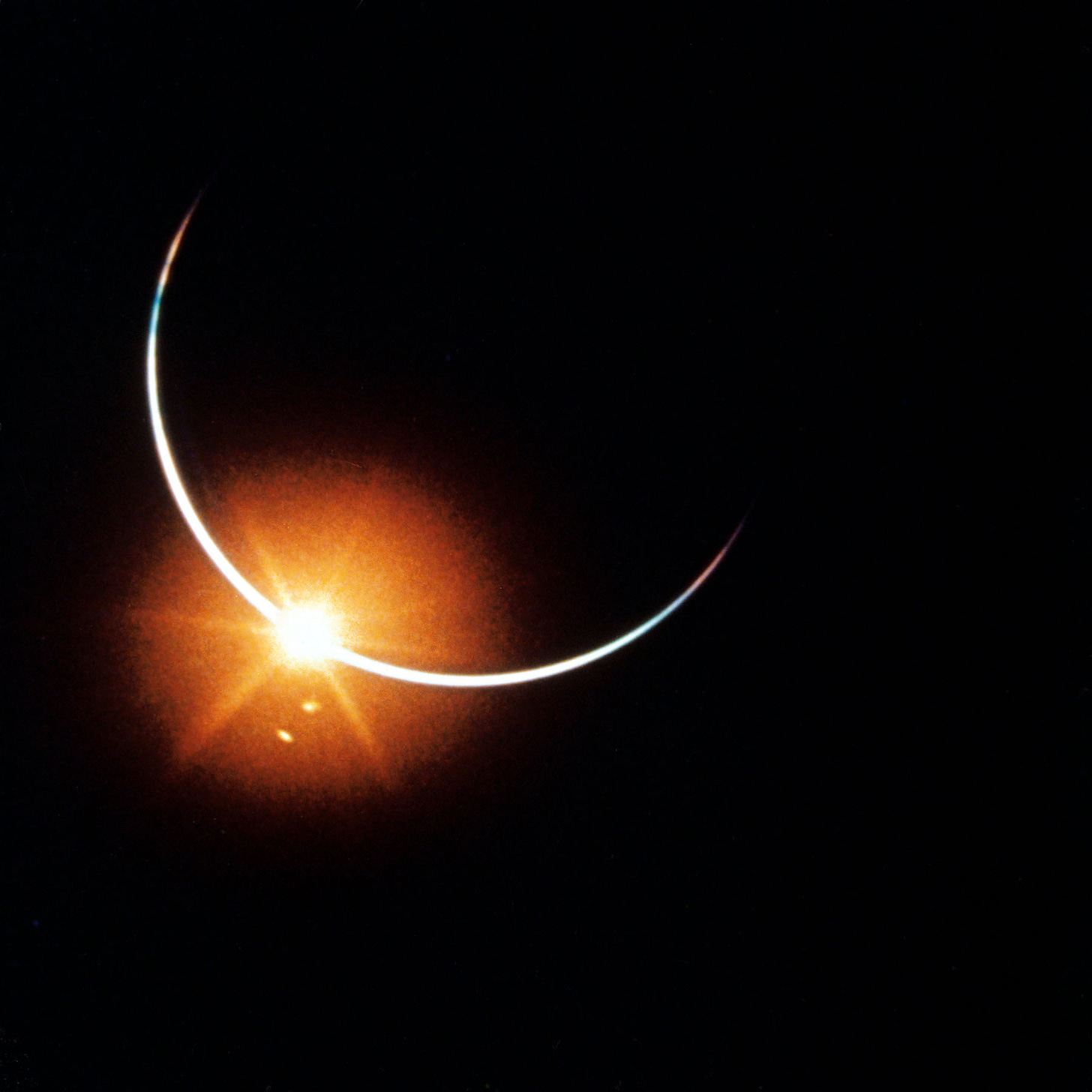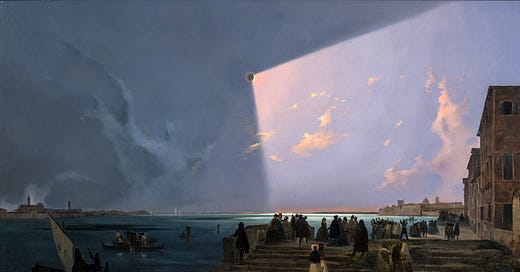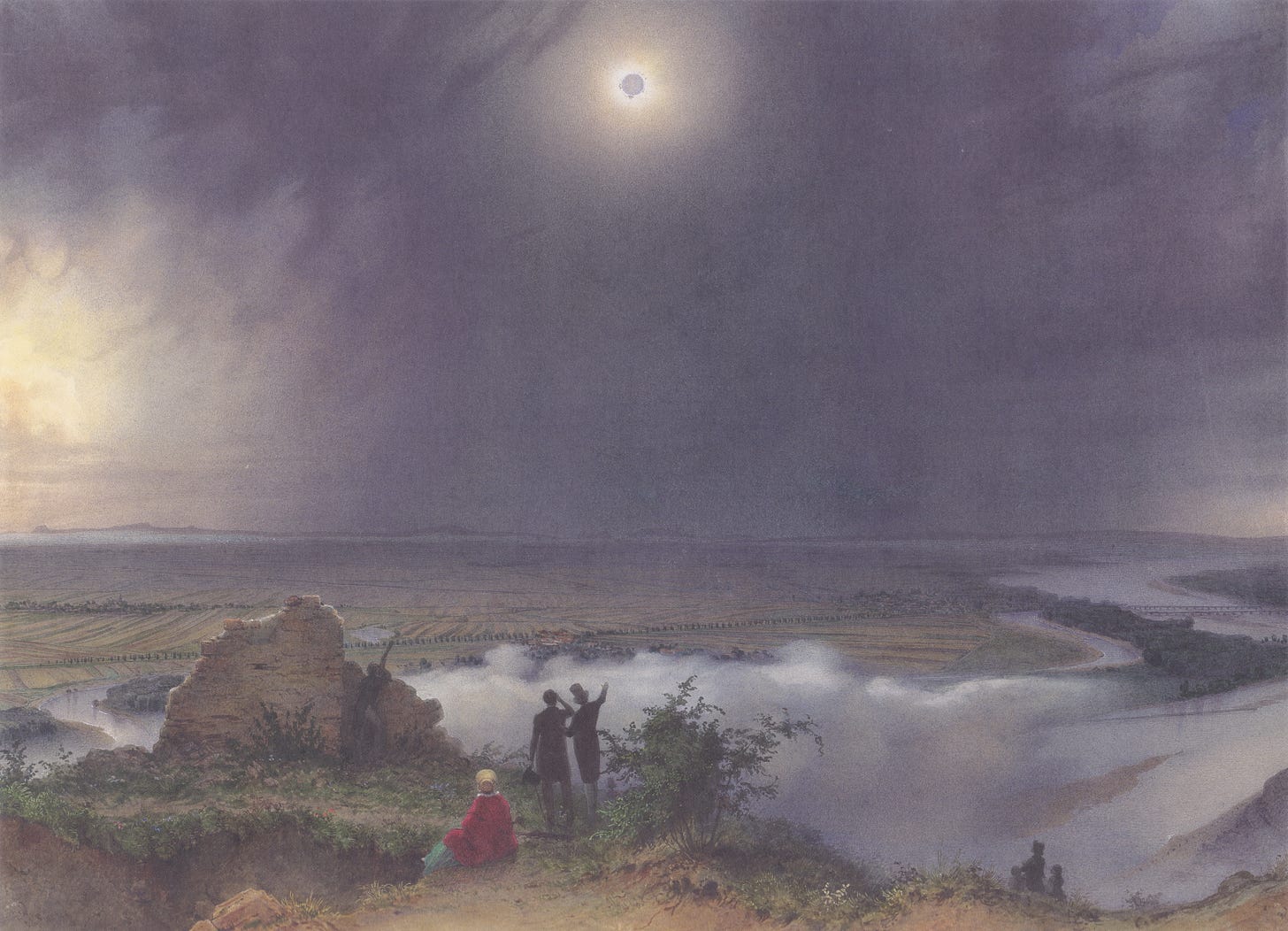Occasionally Scheduled Reminder That You Live on One of Several Celestial Bodies Dancing Together
Total solar eclipses: utterly non-magical and utterly wonderful 🌑
My first thought is that it didn’t last long enough. It so happened that our home was in the path of totality, but, like half of the the city of Montreal, only barely (the other half, not at all); the total eclipse would last just a bit over one minute, and feel like ten seconds. So we drove 1.5 hours to the town of Magog, on the shores of a large lake, where the totality would take all of three minutes and a half. It still wasn’t long enough. I took some photos, probably too many; each time the camera took its own sweet time to refocus, eating away precious seconds. The pictures aren’t even that great, though I’m glad I took them. I do feel I should have spent more time looking at the obsidian black Moon and the ghostly remnants of the Sun around it, but it probably wouldn’t have mattered: however long it was, it would not have been enough.

My second thought is that, fortunately, there are more total eclipses to come. But they will require long flights instead of an optional 1.5-hour drive. One of them will last more than six minutes outside of Luxor, the ancient Egyptian capital that was called Waset or Thebes, three years from now. To celebrate the Sun and Moon in the desert, among the ruins of a civilization that was obsessed with them, is the classiest way to do it I can think of.
My third thought is that I need, right now, to make a special, conscious effort to remember the details that weren’t captured on the photos, so that they do not fade from memory. There was the strange, bleak light that covered the land a minute before, when the Sun was almost but not quite entirely covered by the New Moon; the rays of the Sun were still reaching us, but they were visibly weak, and everything felt a little colorless. There was the spell of cold that we felt at that time. There was the sudden deep-blueness, and then: the totality. There was the eerie 360° dawn on the entire horizon, as if the Sun were about to rise from everywhere at once, when it was in fact right there in front of us. There was the bird that flew near the ground in stupefied confusion. There were Jupiter and Venus (and Mars and Saturn and Mercury, but those were not bright enough to be seen). There were the surprisingly long filaments of the solar corona, too pale to be seen on pictures, but stretching like strands of silk into the tapestry of space. There was, at the bottom of the invisible sun disk, on the white ring of residual light that circled the Moon like structurally impossible jewelry, a pinkinsh-red spot, a solar prominence of erupted plasma, away from the surface of the star. It felt like a dead pixel in the sky. Something that shouldn’t happen; a glitch.
That’s what a total eclipse feels like, and it is occasionally described as such: a glitch. A wrongness. “Like the death of someone, irrational, that sliding down the mountain pass and into the region of dread,” wrote Annie Dillard in her 1982 essay Total Eclipse.
From there all sorts of sinister associations can be made. Darkness seemed to be devouring light. The life force of the world seemed to be drained away. Nothing is easier than to interpret a total eclipse as a sign of apocalyptic times to come. They say (though not all historians agree) that such an event interrupted a battle between the Medes and the Lydians on May 28th, 585 BC: after such an omen, the only thing left to do was to negotiate peace.
We watched the eclipse of 2024 in Magog, named after the nearby lake in the Abenaki language, Memphremagog, but which readily brings to mind Gog and Magog, Biblical entities of an uncertain nature, perhaps people, perhaps countries, perhaps even monsters, who are supposed to ally with Satan and wage war against God at the end of days. Did I mention that Lake Memphremagog, like the Loch Ness, is said to be the dwelling of a serpentine monster? But the monster, if it exists, was surely in the sky: a black pupil, surrounded with red veins and a silky white sclera, watching us from deep outer space. A creature of cosmic proportions, whose eye peered at us for three minutes and a half before going back to its slumber. A Lovecraftian warning of the horrors that lurk out there, just beyond the farthest reaches of human understanding.
… But no. Nobody thought any of this, while watching the eclipse at Magog. It was strange, it was like something that shouldn’t happen, but what we felt was awe, and dazzlement, and beauty; not horror.
A total eclipse of the Sun is not the manifestation of an incomprehensible creature. Quite the contrary: it is a simple thing, perfectly and utterly understood. The blocking of the light from a celestial body, by another celestial body, as seen on a third celestial body. That’s it. We can calculate the precise timing and location of all eclipses, millions of years into the past or future. Someday, when space travel has become cheap enough that we do it for pleasure and novelty, we’ll be able to witness eclipses whenever we want, simply by steering a spaceship to the precise spot where the Moon or Earth are aligned with the Sun. It’s all just pure celestial mechanics.

But until that happens, it’s extraordinarily rare celestial mechanics, which is why it is so awesome and dazzling and beautiful. In a parallel world, perhaps, total eclipses could have been banal: if the orbit of the Moon around the Earth was in the same plane as the orbit of the Earth around the Sun, instead of being slightly offset as it is in reality, solar eclipses would occur every month, at each new moon. More probably, though, the Moon in that hypothetical other world would be too small or too far for solar eclipses to occur at all; or too large or too close to provide the spectacular ring and corona that we can witness thanks to the incredible coincidence in the apparent sizes of the Sun and Moon.
So we are fortunate that eclipses exist as they are. They might be as rare as life itself, or rarer. Aliens on their exoplanets may not be so lucky. People in the far future also will not, when the Moon, ever so slowly escaping the gravitational clutches of the Earth, ends up orbiting just far enough for all solar eclipses to be annular at best.
There’s an old cliché that science, by uncovering mystery after mystery, sucks out the magic and wonder of the world. The first part might be true: thanks to astronomy, not even particularly advanced astronomy, eclipses have ceased to be magical long ago. They are no more magical than casting a shadow by putting your hand next to a lamp is. But anyone who has watched a total solar eclipse knows, viscerally, that the part about wonder is totally off the mark. It is obvious that science does not destroy wonderment. As obvious as a dark lunar disk in front of a white sun. How could anyone ever think otherwise?
I suppose one might think that if one has only seen a partial solar eclipse and thought, that’s it? Reader, if this is you: that is not it. Not even close. Make the trip to Spain or Egypt or Australia if you can. It is worth it, more than almost anything else you could travel to go see.
My final thought is that there must be more. There must be more than just rarity, to explain the wonder and beauty of a total eclipse of the Sun. Lots of things are rare; few are transcendent. If I were to guess, I would say it is because an eclipse reminds us of the nature of reality. The Sun and Moon, and the planets, dance around us; but too often we fail to notice. We usually don’t know how the Moon works, though it’s easy to figure it out; we never truly look at the Sun, since that requires special equipment; we can’t even tell the difference between a star and a planet in the night sky. We treat astronomy as something optional, cool to do as a hobby but ultimately inconsequential.
But occasionally, the dance of the celestial bodies makes a spectacular move. And then it is hard not to think of how we, the humans, and our entire family of living beings from bacteria to trees to birds, also live on a celestial body, and are also part of the dance.







"That’s what a total eclipse feels like, and it is occasionally described as such: a glitch."
Well, in a sense, it IS a glitch: what we see is very much a coincidence of the relative distances and diameters of the moon and the sun. If either of them had been different size or different distance from Earth, there would be no "magic".
I’m glad I read this when I did. I lost a friend today, and sometimes a reminder of the hugeness of the universe is a comfort in moments of chaos like this. Xxx